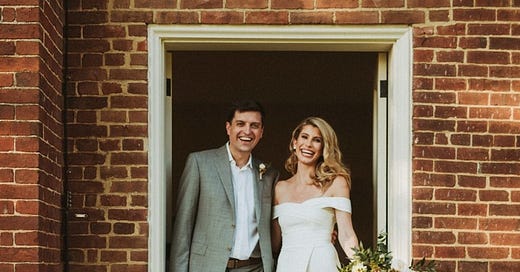Two Weddings, One Marriage
The Gist: As you plan your wedding, elevate the higher purpose and your particular priorities. Relax about everything else.
A recounting of my own experience and a review of A Practical Wedding and Man Nup.
The third of a three-part exploration of the marriage mindset. Click here to read part one: Marriage Recommended, and here to read part two: Derisking Marriage.
We probably should celebrate 10 year anniversaries rather than weddings – they’re rarer.
But until that sensible change, I can report on my own unusual experience of two very different weddings in my single marriage to one woman – the first, thanks to covid restrictions, was a sublime, deeply intimate interaction with just my wife, our pairs of parents, and our pastor and his wife. I read about monetary policy as Ashley got ready, we went to the church and underwent a divine arrangement, then all had dinner at our favorite restaurant. I had been looking forward to a big wedding and found myself thoroughly enjoying a small one.
Figure 1. I will no doubt remind any future daughter that her mother got married in a dress acquired for under $100.
A year later (alas, not 10!), we invited lots of friends and family to a considerably larger celebration that was a whirlwind of reconnections and fun, beginning with an outdoor welcome reception at a Nashville hotel the evening before. The day of I got to joke around and play a favorite game with my groomsmen while Ashley brunched and got ready with her bridesmaids, our pastor came back for a sermon of celebration, and then we spent the rest of the evening catching up with as many people as we could. I had thoroughly enjoyed a small wedding and found myself loving a big one.
Along the way, I read two helpful books – the first, delightfully titled Man Nup by Rick Webb, contains the sound advice that “wedding planning is not rocket science. It’s event planning.” The second, practically titled A Practical Wedding by Meg Keene, contains the best advice of all: Figure out the small number of things you really want to go right and relax about pretty much everything else.
For us, the three things we wanted to go right were the dress, the photography, and the spoken word. While leggings and a comfy sweatshirt are a great daily go-to, Ashley, a former pageant finalist, felt rather strongly about getting the right look. Photography would serve as our enduring memory aid to the joy of these days and also as decor in our shared future home. And I, a former congressional primary finalist, felt rather strongly about the power of good speeches.
Figure 2. Here you can easily see that 2/3 priorities went well!
For everything else, we created a spreadsheet with every possible line item and then ranked them in order of importance, with next immediate actions identified, both ideal and latest dates to complete them by, any links, whether it was delegable or had to be done by the bride or groom, and, finally, a specific argument for why each thing needed to be kept. It’s helpful to throw everything you might possibly want onto a list and then evaluate whether you really do in fact want it. The ultimate question: What is going to bring us joy and laughter on the day of our wedding?
Keene well illustrates that a great many wedding “traditions” we think of are actually just a few decades old and often the result of the wedding industry trying to grab every possible dollar. We skipped such necessities as party favors, unity candles, even wedding cake. Indeed, “For hundreds of years, weddings in the United States took place in people’s homes. During World War II, a huge number of weddings took place at the courthouse with the bride in her best clothes, always with flowers.” We did embrace certain things we liked – but with full knowledge of their recent vintage: “the bridal bouquet (emerged around the turn of the twentieth century; before that women held prayer books or handkerchiefs), the once-worn formal white dress (became popular in the early to mid-twentieth century thanks to a serious marketing effort), the catered reception (came into vogue in the 1950s).” Perhaps the most famous creation of a tradition was the mass marketing campaign in the early twentieth century by the diamond monopoly De Beers to convince the world that serious engagements require their product – and you should keep said diamonds forever so that you never discover that their value on the secondary market is rather less than precious.
Figure 3. In some cases, though, the value in the secondary market is not visible in pure price. For our engagement in the Smokies, I got a hold of Ashley’s grandmother’s wedding ring – a symbol of a great love that preceded ours! As for myself, I succumbed to the cool marketing of a wedding ring made out of meteorite.
Quite related to the general list of things you might consider or reject is your budget. As with any major decision or expense, you should attempt to look at the base rate of how these things typically go. Specifically, you should look at the regional averages for how much money (and what percentage of an average total wedding budget) is spent on each line item to get a sense of reality-testing what your expectations are. At the same time, Webb warns that “The wedding industry is designed from the ground up to make you feel insecure about your decisions, and to invoke fear in order to get you to throw more money at a particular aspect of the production… Most vendors have a whole sales approach, and it invariably revolves around preying on the bride’s insecurities, hopes, dreams and childhood fantasies.”
The best way to steel yourself against such salesmanship is the most important line in your budget: Savings. The money you do NOT spend on your wedding can instead be used for future vacations, or a down payment on a house, or invested in the S&P 500 for a compounded return. Resources are finite! By all means, splurge on the three things that are most important to you (fun fact: speeches are cheap.) But also feel liberated to NOT spend the average cost or percentage on things you don’t really care about. As ever, remember price is what you pay and value is what you get. For my best friend, this analysis translated into an elopement – and he and his wife are still filled with joy thinking back on it. For another friend who wanted a bigger party, he got married at the courthouse and invited all of his friends to a bar.
Of course, not everyone can enjoy the benefits of an old line Baptist wedding where savings can be achieved in alcohol and dancing. No, for a great many Americans alcohol is an addictive substance that they’ve become accustomed to acquiring on demand and are less than enthused about a cash bar (never mind my idea to try to turn a profit on the wedding). And anthropologists have concluded that rhythmic noises have long had a role in human culture and appear to boost collective mood (though the nice thing about hosting something in Music City is that even the third string options are great – though a DJ could save even more).
Amazingly enough, there have been significant technological advancements in communications that allow for you to invite people to your wedding – for free – through the interwebs. A variety of rentals are generally expected because guests may not be excited about standing at length, in rain, struggling to hear shouting speakers – but you do not require handcrafted antiques. Hair, facial, and nails might require budget lines because the dead and dying parts of the body require maintenance, at least for the female of the species. And although my wife is renowned for her ability to get dolled up in the car (even, alarmingly, while driving), a dedicated professional is necessary to achieve that “bride of Frankenstein” look.
Figure 4. Dead and dying plants are also apparently romantic, fragrant, and beautiful.
I joke about these things to try to get you to take everything less seriously – and to encourage you to get creative in freeing up cash for what you really want to do (either your priorities within the wedding itself or generally in life.) As Keene advises, “when you leave a great party, you’re normally raving about how fantastic the people were, not about how the favors perfectly matched the tablecloths.” And, “when you look back at your wedding… you won’t care too much about how the details looked; you’ll care about how you felt.” We never especially liked the idea of a formal (and finite) rehearsal dinner, so we just threw an open, casual welcome party. Until offered a ride the day of, I was just planning to UberX to my wedding. And we simultaneously embraced our own personalities as well as saved a bunch by insisting on serving a favorite food since our very first date: pizza.
All that being said, before you immediately seize a bargain (or otherwise hire on reputation), you should actually meet and get along easily with your vendors as well as review their work-product – taste-test the pizza (we even got to make our very own flavor of ice cream!), listen to the band (live if possible), sit in the chairs. As we examined venues, there was one promising historical home that looked good online – but when we arrived, we discovered it was next to a highway and railroad tracks. “ARE THE TRAINS ALWAYS RUNNING?” I asked our hostess. “OH, YOU GET USED TO THEM!” she confidently replied. We wound up getting married at Andrew Jackson’s home, the Hermitage – which had indeed topped our separate scoring of various venues but what really clinched it for my wife was my observation that the top alternatives were just private property that could be the site of a McDonald’s in 15 years.
Naturally, a lot of these questions revolve around one number: how many people you invite to your wedding. In our last correspondence, I mentioned the amusing but puzzling statistic that if you have a BIG wedding with lots of people, you are less likely to get divorced — but if you have an expensive wedding, you are MORE likely to get divorced. But I figured out how it works when attending the wedding reception of a Mormon friend: they had gotten married for free at the temple and then hosted a really big party at the groom’s parents’ home, most everyone standing closely together grabbing finger foods (but, obviously, no alcohol) all for a fraction of the average wedding cost – and, you know what? It was a blast!
Webb suggests that you should start out with the assumption that you shouldn’t invite anyone you haven’t seen or talked to in a year (all the more true if you’re picking a bridal party – my best man has known me the longest of anyone: my dad.) To the degree that family is demanding people be invited, compel them to rank-order their list so that you can have a conversation with full knowledge about where their priorities are. Apparently, the base rate of rejection is something like 10%+ for locals and 30% for out-of-towners – though if you are getting married in a cool city, expect more people to make the trip. There are also the non-responders. Tracking down my college roommate on the day after the RSVP deadline, he told me “Move me from a maybe to a probably.”
But my biggest recommendation – to my wife, now to you – is to try to figure out how to absolutely minimize the stress and work that goes into guest sorting (and, indeed, the whole wedding planning). What that practically meant for us: no seating chart. I did not want my wife agonizing over where to place who.
Figure 5. We had an additional wrinkle as well: the seating capacity of our church, originally built by Jackson for his family to worship, was smaller than our guest list. I suggested the obviously most efficient way to deal with this was to auction off seats. When this was sadly rejected, we thankfully agreed that we would allow the first people to RSVP to come.
Perhaps Keene’s best line in her book is that a bridesmaid’s job is to keep crazy at least 10 feet away from the bride. That’s certainly helpful during the wedding itself. But in the entirety of the planning process, pursue calm – get enough sleep, eat healthy, and spend quality time together as a couple (for us, that was reading, walking, praying, laughing, and socializing with close friends). I also arranged for Ashley to get regular massages throughout.
If your family won’t allow you to auction off seats or charge for food and drink, your only other profit opportunity is the gift registry (which, according to one analysis, is basically the only visited page on your wedding website). I have one close friend who invited everyone he ever met to his wedding – and then made getting to it as inconvenient as possible (our route to get there quite literally involved planes, trains, and automobiles). Result? Maximum gifts, minimum cost.
In reality, we tried to tell our guests that, in lieu of a gift, we would greatly cherish a handwritten note of encouragement and personal reflection. Nevertheless, many people did indeed get us gifts – surprisingly, even some that were not invited. We listed practical luxuries like skillets, pizza scissors, and shotguns; we offered the popular opportunity to finance particular aspects of our honeymoon; and we availed guests of the options to finance our book budget or investment fund.
And yet, as Dwight Eisenhower reflected, while planning is indispensable, plans are useless. You’ve got to be prepared for contingencies – perhaps something as basic as being able to use the programs as a fan during a heatwave but also something as drastic as having to rethink the whole idea during a pandemic. As we approached our first wedding date, we were continuously uncertain as to whether we’d be able to have it all amidst covid. As we got nearer and it looked like Nashville wouldn’t allow a party of our size, we had to think: should we scramble for a last minute venue in freer, more rural Tennessee? Should we convert the whole wedding to a Star Wars theme so that people could plausibly wear breathing apparatuses? Should we postpone everything and how would we know when would be permissible? As noted, we wound up getting married in an intimate ceremony and then celebrating in a bigger way on our one year anniversary. But even then things popped up – one groomsman got covid the week of! As Keene advises: “One of the gifts of your wedding day is the fact that you can choose, over and over again, in each moment, how you react to the things that go wrong. You can choose to allow the bigness of your commitment to take a front seat to the disappointments. ‘Perfect weddings don’t exist’” Adapt and overcome!
Figure 6. One guest got dressed up to go to our wedding and realized in his final step that he had forgotten his tie. Calling an Uber to the venue, he asked to stop at any plausible store that might sell one. One, two, three, four stops later he finally manages to secure a tie and get it on in the car – but throughout he’s thinking “Am I going to be the only schmuck without a tie?” But then he arrives and immediately runs into one of my groomsmen and, spotting his collar, asks “No tie?” “Oh no,” my groomsman replies. “Grant and Ashley decided no ties.” So he made the long walk to the church thinking “Am I going to be the only schmuck with a tie?” (He was not.)
As we approached our second wedding date, we had been keeping loose track of how our finalized and cut-down spreadsheet was being marked off but a month away, we really devoted all of our attention to making sure that everything indeed was ready and, in particular, distributing specific and detailed day-of plans to everyone involved (though we couldn’t be perfect: one local guest miswrote the date and arrived at the church one week early to witness a different wedding altogether.)
I should mention one other bit of planning – it’s apparently unconventional and it really isn’t done by you. I can’t tell you the number of weddings I’ve been to in which I run into the best man on the very day of, already a little tipsy, somewhat bragging, somewhat worried that he has a speech to give that night and he hasn’t begun preparing. That tends not to be a recipe for success, leading to the all too typical speech in which tears flow, obscure events are referenced, inappropriate remarks are made, and an opportunity is wasted to commemorate a moment for dear friends before a crowd.
Instead, we set aside time for – and made a centerpiece of our wedding – thoughtful, heartfelt speeches from our closest friends who have the ability. We carefully selected speakers, alerted them well in advance that this was important to us (and may even have provided pointers), and asked, as a gift, for a transcript of their notes after they had spoken. The results were deeply moving for Ashley and me. And, of course, the speeches followed a wonderful sermon by our pastor (a dear friend) as well as specifically selected readings from the Bible of personal inspiration. To keep things running smoothly (and amusingly), I also asked my longtime collaborator in humorous speechmaking to be master of ceremonies – a position he filled masterfully in setting up the crowd and cracking jokes. And I took the opportunity personally to conclude the speeches with one of my own, reflecting on our marriage and the wonderful opportunity to know the people present. In the end, I was delighted to be told again and again by guests that they were the best set of speeches they had heard at any wedding!
Figure 7. After speeches, we shuffled along for a first dance, followed by father and daughter and mom and son. The latter efforts were complicated by the particular musical tastes of our parents. For my father-in-law, we struggled to find a slow dance in the ACDC catalog. My mom’s only musical interest that originates after 1800 is the Bee Gees – and you’ll find that the lyrics of most everything they have sung don’t exactly lend themselves to the occasion.
It was a (second) magical day – from photography around the estate, to ceremony in the old church, to drinks in the gardens, to dinner and speeches and dancing under a big tent. And, to end it all, we borrowed an idea from another friend to have an exit line in which we could say goodbye to every person who attended and be the last to leave ourselves!
Figure 8. Ashley had originally wanted to go to Italy for our honeymoon – but, alas, covid again intervened. So we instead went to the Italy of the United States: Wyoming!
There were other things on the margins that nevertheless can take up a great deal of time – plotting moving in together (strongly correlated with increased snuggling), Ashley changing her surname. But the best thing that we did after our honeymoon was sit down and record all of our memories for posterity. We had wanted a few things to go right. Turns out everything went right.
Figure 9. Click here to acquire Man Nup by Rick Webb – a strong 7. Good overview for how things should go, nothing crazy, generally good advice from the groom’s perspective (at least one actively involved.)
Figure 10. Click here to acquire A Practical Wedding by Meg Keene. Approaching a 7. There’s some very good advice in here (which I’ve pulled out for this newsletter) but there are some jarring voice changes. Especially good in revealing that many “traditions” are really upsells and that you should focus on the most important things. Not as relevant for us but certainly for other couples: “A wedding is not a surprise party for the groom.” We agree: “Planning a major event with your partner is going to help you develop skills for working together that you’ll use for years.”
Thanks for reading! If you enjoyed this, forward it to a friend: know anyone planning on getting married? How about someone who just loves weddings? Or anybody who has ever been or might be married?
For more, check out my archive of writings, including my review of the Five Love Languages.
I read over 100 non-fiction books a year (history, business, self-management) and share a review (and terrible cartoons) every couple weeks with my friends. Really, it’s all about how to be a better American and how America can be better. Look forward to having you on board!
Figure 11. You’ve reached the bottom!














